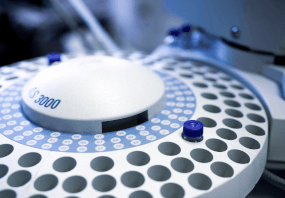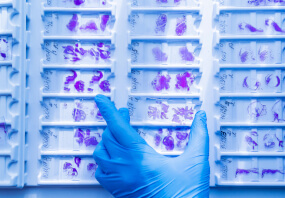General description
Double homeobox protein 4 (UniProt Q9UBX2; also known as Double homeobox protein 10) is encoded by the DUX4 (also known as DUX10) gene (Gene ID 100288687) in human. DUX4 is a double homeobox transcription factor that is normally expressed in the testis. Contraction or hypomethylation of D4Z4 macrosatellite repeats on chromosome 4q35 causes aberrant DUX4 expression in skeletal muscle, a hallmark of the incurable disease facioscapulohumeral muscular dystrophy (FSHD), characterized by skeletal muscle weakness and wasting. Gene expression data analysis identifies β-catenin as the main coordinator of FSHD-associated perturbation of protein interaction signallings, including those of canonical Wnt, HIF1-α and TNF-α. In addition, DUX4 expression causes proteolytic degradation of UPF1, a central component of the nonsense-mediated decay (NMD) machinery, and accumulation NMD substrate RNAs including DUX4 mRNA, such that NMD downregulation by DUX4 expression stabilizes DUX4 mRNA through a double-negative feedback loop in FSHD muscle cells. FSHD muscle expresses a low abundance DUX4 mRNA that produces the full-length DUX4 protein. In contrast to control skeletal muscle and most other somatic tissues, full-length DUX4 transcript and protein is expressed at relatively abundant levels in human testis, most likely in the germ-line cells. Induced pluripotent (iPS) cells also express full-length DUX4 and differentiation of iPS cells to embryoid bodies suppresses expression of full-length DUX4, whereas expression of full-length DUX4 persists in differentiated FSHD iPS cells.
Specificity
Clone P4H2 is specific to DUX4 (UniProt Q9UBX2) and does not recognize DUX4c (DUX4L9; UniProt Q6RFH8) or the spliced DUX4 short isoform DUX4-s (UniProt E2JJS1) that lacks the C-terminal epitope region targeted by clone P4H2 (Geng, L.N., et al. (2011). Hybridoma (Larchmt). 30(2):125-130; Snider, L., et al. (2010). PLoS Genet. 6(10):e1001181).
Immunogen
GST-tagged recombinant human DUX4 C-terminal fragment.
Application
Detect DUX4 using this mouse monoclonal Anti-DUX4 Antibody, clone P4H2, Cat. No. MABS1348, validated for use in Immunocytochemistry and Western Blotting.
Research Category
Signaling
Western Blotting Analysis: 1 µg/mL from a representative lot detected DUX4 in 10 µg of human heart and ovary tissue lysates.
Immunocytochemistry Analysis: A representative lot detected full-length DUX4 (DUX4-FL) nuclear immunoreactivity at a higher frequency among differentiated CD56+ myogenic cells from facioscapulohumeral dystrophy (FSHD) than non-FSHD individuals (Jones, T.I., et al. (2012). Hum. Mol. Genet. 21(20):4419-4430).
Immunocytochemistry Analysis: A representative lot detected exogenously expressed full-length human DUX4 (DUX4-FL) in 2% paraformaldehyde-fixed and 1% Triton X-100-permeabilized C2C12 mouse myoblasts (Geng, L.N., et al. (2011). Hybridoma (Larchmt). 30(2):125-130).
Immunocytochemistry Analysis: A representative lot and another DUX4 antibody that targets an N-terminal region epitope co-stained full-length DUX4 (DUX4-FL) in the nucleus in ~0.1% of cultured facioscapulohumeral dystrophy (FSHD) muscle cells fixed with 2% paraformaldehyde and permeabilized with 1% Triton X-100 (Snider, L., et al. (2010). PLoS Genet. 6(10):e1001181).
Western Blotting Analysis: A representative lot detected exogenously expressed human DUX4, but not DUX4c, in transfected C2C12 mouse myoblasts. No target band was detected in lysate from untransfected cells (Geng, L.N., et al. (2011). Hybridoma (Larchmt). 30(2):125-130).
Western Blotting Analysis: A representative lot detected DUX4 immunoprecipitated from human testis tissue lysate by another DUX4 antibody that targets an N-terminal region epitope (Snider, L., et al. (2010). PLoS Genet. 6(10):e1001181).
Quality
Evaluated by Western Blotting in human testis tissue lysate.
Western Blotting Analysis: 0.5 µg/mL of this antibody detected DUX4 in 10 µg of human testis tissue lysate.
Target description
~60/45 kDa observed. 44.94 kDa calculated. The larger-than-calculated target band size is consistent with that reported in the literature (Geng, L.N., et al. (2011). Hybridoma (Larchmt). 30(2):125-130; Snider, L., et al. (2010). PLoS Genet. 6(10):e1001181). Uncharacterized bands may be observed in some lysate(s).
Physical form
Format: Purified
Protein G purified
Purified mouse IgG1 in buffer containing 0.1 M Tris-Glycine (pH 7.4), 150 mM NaCl with 0.05% sodium azide.
Storage and Stability
Stable for 1 year at 2-8°C from date of receipt.
Other Notes
Concentration: Please refer to lot specific datasheet.
Disclaimer
Unless otherwise stated in our catalog or other company documentation accompanying the product(s), our products are intended for research use only and are not to be used for any other purpose, which includes but is not limited to, unauthorized commercial uses, in vitro diagnostic uses, ex vivo or in vivo therapeutic uses or any type of consumption or application to humans or animals.
- UPC:
- 12352200
- Condition:
- New
- Availability:
- 3-5 Days
- Weight:
- 1.00 Ounces
- HazmatClass:
- No
- MPN:
- MABS1348












